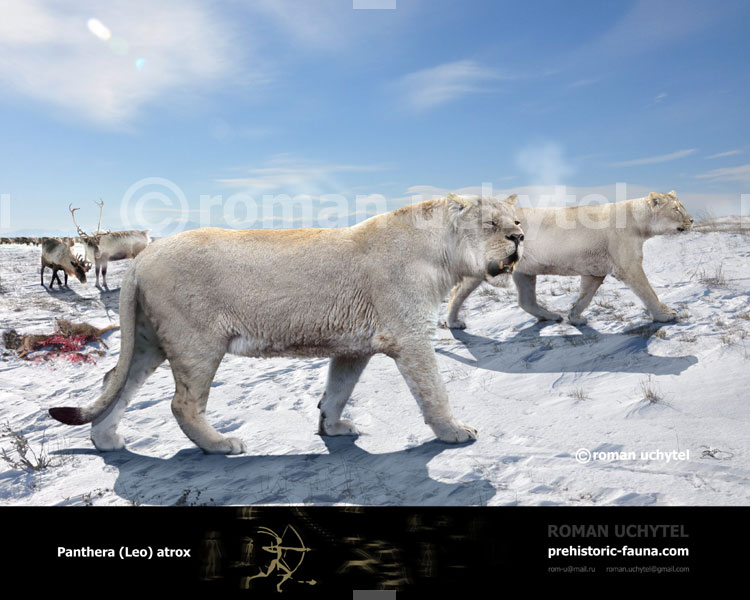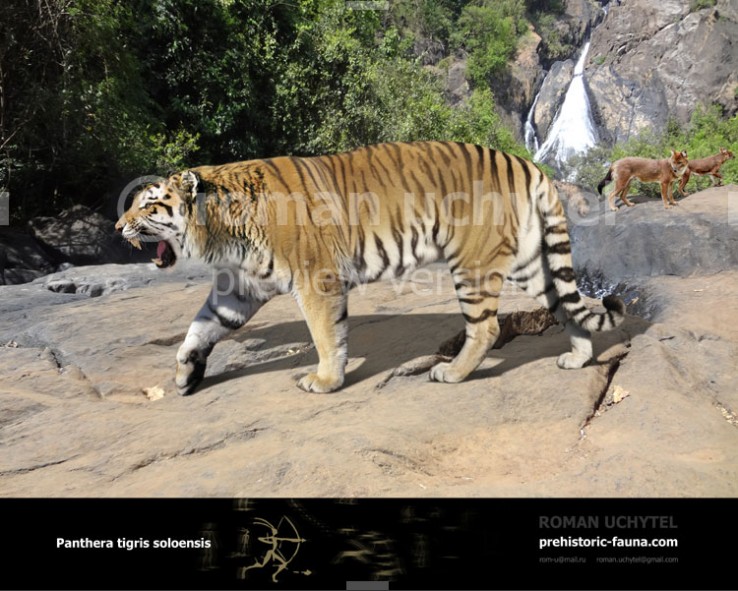Post by rock on May 27, 2019 19:48:40 GMT 5
American Lion - Panthera leo atrox
The American lion (Panthera leo atrox or P. atrox) — also known as the North American lion, Naegele’s giant jaguar or American cave lion — is an extinct lion of the family Felidae, endemic to North America during the Pleistocene epoch (0.34 mya to 11,000 years ago), existing for approximately 0.33 million years. It has been shown by genetic analysis to be a sister lineage to the Eurasian cave lion (Panthera leo spelaea or P. spelaea). The American lion is an extinct animal which originated in North America and went on to colonize part of South America as part of the Great American Interchange. The head-body length of the American lion is estimated to have been 1.6–2.5 m (5 ft 3 in–8 ft 2 in) and it would have stood 1.2 metres (4 ft) at the shoulder. Thus it was smaller than its contemporary competitor for prey, the giant short-faced bear, which was the largest carnivoran of North America at the time. The American lion was not as heavily built as the saber-toothed cat Smilodon populator, which may have weighed up to 360–470 kilograms (790–1,000 lb). Sorkin (2008) estimated it to weigh roughly 420 kilograms (930 lb), but new estimations show a top weight of 351 kg (774lbs.) for the largest specimen and an average weight for males of 255.65 kg (563lbs.).

Ngandong Tiger - Panthera tigris soloensis
Panthera tigris soloensis, known as the Ngandong tiger, is an extinct tiger subspecies, which occurred in the Sundaland region of Indonesia during the Pleistocene epoch. The few remains of the Ngandong tiger suggest that it would have been about the size of a modern Bengal tiger. However, given the size of other remains, it may have been larger than a modern tiger. Heltler and Volmer (2007) estimated that a large male could have weighed up to 470 kg (1,040 lb), in which case, it would have been heavier than the largest extant tiger subspecies, and similar to Smilodon populator.
NOTE: The Ngandong tiger was only about 235 kg average.

Credit to Wikipedia
The American lion (Panthera leo atrox or P. atrox) — also known as the North American lion, Naegele’s giant jaguar or American cave lion — is an extinct lion of the family Felidae, endemic to North America during the Pleistocene epoch (0.34 mya to 11,000 years ago), existing for approximately 0.33 million years. It has been shown by genetic analysis to be a sister lineage to the Eurasian cave lion (Panthera leo spelaea or P. spelaea). The American lion is an extinct animal which originated in North America and went on to colonize part of South America as part of the Great American Interchange. The head-body length of the American lion is estimated to have been 1.6–2.5 m (5 ft 3 in–8 ft 2 in) and it would have stood 1.2 metres (4 ft) at the shoulder. Thus it was smaller than its contemporary competitor for prey, the giant short-faced bear, which was the largest carnivoran of North America at the time. The American lion was not as heavily built as the saber-toothed cat Smilodon populator, which may have weighed up to 360–470 kilograms (790–1,000 lb). Sorkin (2008) estimated it to weigh roughly 420 kilograms (930 lb), but new estimations show a top weight of 351 kg (774lbs.) for the largest specimen and an average weight for males of 255.65 kg (563lbs.).

Ngandong Tiger - Panthera tigris soloensis
Panthera tigris soloensis, known as the Ngandong tiger, is an extinct tiger subspecies, which occurred in the Sundaland region of Indonesia during the Pleistocene epoch. The few remains of the Ngandong tiger suggest that it would have been about the size of a modern Bengal tiger. However, given the size of other remains, it may have been larger than a modern tiger. Heltler and Volmer (2007) estimated that a large male could have weighed up to 470 kg (1,040 lb), in which case, it would have been heavier than the largest extant tiger subspecies, and similar to Smilodon populator.
NOTE: The Ngandong tiger was only about 235 kg average.

Credit to Wikipedia




